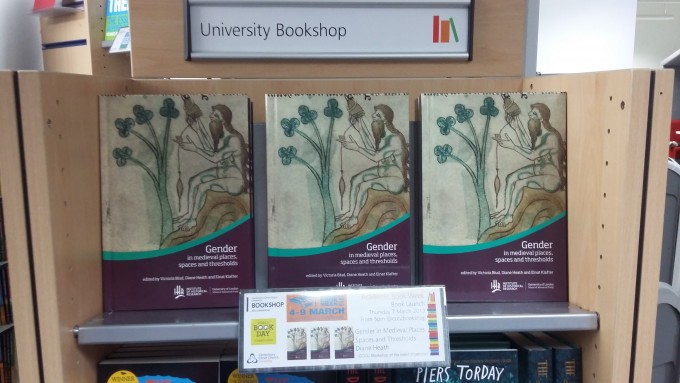Before I get to the book launch and a meeting on mapping Faversham through time, I thought I would mention that the CCCU Kent History Postgraduates will be holding their monthly seminar next Wednesday. Our two presentations will be given by Janet Clayton, whom many of you will know is studying Scadbury manor and the surrounding area with special reference to the High Middle Ages, and Abigail Sargent. It will be great to welcome Abigail because she is doing her doctorate at Princeton University in the United States. Currently, she is on an archival research trip studying peasant communities in Kent and Normandy, again looking specifically at the High Middle Ages. Obviously, there will be a report on this seminar next week.
In addition, I thought I would note a few events that will be taking place in the week beginning 18 March. On that Wednesday there will be the Centre’s second contribution to the Women’s History Month when we will be holding a workshop where students and staff can explore primary sources, probably predominantly from the Canterbury medieval archives that offer ways of thinking about ‘Women in the Workplace’. This will be at lunch time between 1 and 2 pm in Lg47, do please book and come along https://www.canterbury.ac.uk/events/general/women-in-the-workplace-in-medieval-times.aspx .
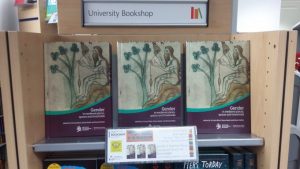
Celebrating World Book Day at the CCCU bookshop [photo Diane Heath]
For those interested in Egyptian archaeology and responses to it, also on Wednesday 20 March there is the Lambarde Lecture at 6 pm in The Michael Berry Lecture Theatre, Old Sessions House. The lecture entitled ‘Artists, archaeology and ancient Egypt: Victorian Painters and their engagement with antiquity’ will be given by an expert in this field, Professor Stephanie Moser (University of Southampton). All welcome so please do go along.
Concerning other events this week, I thought I would report that on Monday I represented the Centre and CCCU History at the quarterly meeting of the Kent History Federation held at the Kent History and Library Centre in Maidstone. As some of you may remember, the Centre co-hosted with the KHF a 1-day conference on Tudor and Stuart Canterbury last May that was very successful: https://blogs.canterbury.ac.uk/kenthistory/tudor-and-stuart-canterbury-universities-working-together/ This was an interesting meeting and with regard to the repercussions, I’ll let you know when things become clear, but after the meeting the KCC Archives team, led by Sarah Stanley, very kindly provided refreshments. While drinking coffee I had another fascinating discussion with Elizabeth Finn on medieval pigs and I also agreed to give a talk at the KCC Archives day on ‘The Diocesan Records of Canterbury and Rochester’ that will be held on Saturday 28 September – conference programme available soon. Among Sarah’s confirmed speakers are Professors Kenneth Fincham and Catherine Richardson, both from the University of Kent, so it is good to have someone from CCCU. I’m going to talk about ‘’Revealing lay piety in late medieval Kent – how useful are wills?’ which will involve examining a range of wills from the dioceses of Canterbury and Rochester to explore how much they can tell us about people’s private and communal devotions in the century before the Reformation. Catherine will be using wills, too, as well as inventories and depositions to look inside early modern houses, and for those interested in this topic her book A Day at Home in Early Modern England: Material Culture and Domestic Life is a brilliant read. Kenneth will consider the Clergy Database, an AHRC-funded project that offers valuable material on Anglican clergy from 1540 to 1835: http://theclergydatabase.org.uk/ . Since Monday, I have heard that Dr Paula Simpson (Trinity College, Cambridge) will also be taking part and some of you may remember Paula from the Centre’s ‘Tithe through the Ages’ conference in 2017: https://blogs.canterbury.ac.uk/kenthistory/celebrating-canterbury-conferences-and-paul-bennett-mbe/
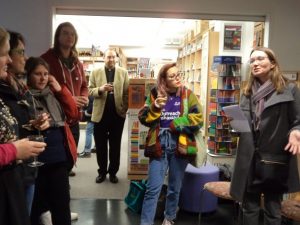
Louise Wilkinson notes the book’s Canterbury contributors
You may also remember Dr John Bulaitis from the same conference, as well as his excellent Nightingale Lecture a few years ago: https://blogs.canterbury.ac.uk/kenthistory/rescuing-ducks-and-liberating-sows-the-kentish-tithe-war/ . John has been busy writing his book on modern tithe disputes, but on Monday he was at the Trustees meeting of the Agricultural Museum Brook. Among the joint ventures between the Museum and CCCU, it is hoped an undergraduate, as part of the Humanities employability module, will help produce some new publicity materials and other information for visitors; and we are also in the process of organising the next Michael Nightingale Memorial Lecture for autumn 2019. This will be given by Carl Griffin, Professor of Historical Geography at the University of Sussex, and he will be speaking on the Swing Riots – a fascinating topic.

People congregating for the book launch
I’ll now get back to the book launch and it was great to see so many students, staff and members of the public gathered together to celebrate this fine (and speedy) achievement. First before I come to the three short talks, I thought I would thank Craig and Colette at the CCCU bookshop for hosting the event and for having copies of the book for sale (there are still more copies and it will also be available at discount at the Tudors and Stuarts History Weekend on Saturday 13 and Sunday 14 April). Having started on the wine – courtesy of Dr David Grummitt, as Head of Humanities – Professor Louise Wilkinson focused on why this is an excellent essay collection by drawing attention to the range of disciplines involved, the scholarship in evidence and the innovative approaches undertaken by many of the contributors. She also underlined the level of Canterbury contributions: articles by Drs Diane Heath, Sheila Sweetinburgh, Jayne Wackett, the Afterword by Dr Leonie Hicks and, of course, that Diane is one of the editors. Additionally, Louise noted that this volume was the product of a great conference that had brought scholars to Canterbury from overseas, as well as a healthy crop of national historians, archaeologists and literary specialists.
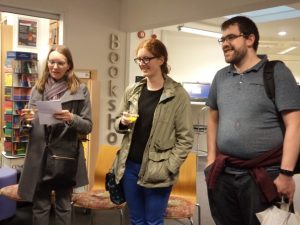
Louise about to raise a toast to the book’s success
Having joined Louise in a toast to the book’s success, enthusiastically endorsed by the audience, I turned to give a short summary of how it is feasible to think about female agency in spatial terms for the ‘lives’ of three religious houses in Canterbury: the establishment of the nunnery of St Sepulchre through the auspices of Archbishop Anselm; the change to a more robust patron for the sisters of St James’ hospital on the city’s boundary at Wincheap/Thanington following a bit of cattle-rustling by Archbishop Baldwin’s supporters; and the production of two registers at St Lawrence’s hospital in the late Middle Ages probably just after there had been a violent skirmish in the hospital grounds. Even though such battles might be less necessary these days, female agency within matters of place and space remain topical, so it seemed only right to toast these female ancestors who had seemingly found ways to negotiate spatial issues for their collective benefit – again enthusiastically endorsed by the audience.
Diane Heath concluded these short speeches by thanking everyone who had been involved in the book’s reception, both at CCCU and at this year’s Gender and Medieval Studies conference at Durham in January. She also noted the speed with which this publication had been produced since the conference, as well as the team spirit within the editing team in their ability to deal with a wide range of contributors, for some of whom English was not their first language. Diane was similarly keen to show how discussions in this collection thrive on the probing of boundaries by which people are let in, kept in, and kept out of places and spaces. Again, such ideas are not solely a matter of history, and she was keen to highlight that this book launch is linked to the CCCU programme for Women’s History Month – International Women’s Day having been the day before. This received an enthusiastic response from the audience, who then returned to celebrating the book more fully by drinking more wine – making this a very satisfying book launch.
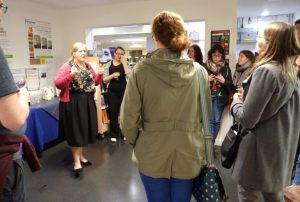
Diane discussing the editing process
Finally, yesterday I was at a meeting hosted by Dr Alexander Kent and John Hills from Geography at CCCU, with a colleague from Poland, who were keen to demonstrate to a group from Faversham, led by Howard Goodwin of the Faversham Society, the potential of GIS mapping for the proposed ‘Heritage Hub’ in 12 Market Place, Faversham. Consequently, among the group were Louise Bareham and Geoffrey Wade for the Town Council, John Owen, Faversham’s local historian, several more from Faversham Society, including those from the Archaeological Research Group, and others representing different heritage organisations in the town.
After John had demonstrated how OS maps and others can be overlaid on each other to illustrate how the town’s built-up area had expanded since the 19th century, there was a wide-ranging discussion regarding how such techniques might be employed for Faversham, who were likely to be the potential audiences and beneficiaries, which heritage groups might want to get involved, how this could be linked to other events, and within the educational uses, how might students – primary to tertiary, local and more widely – become involved and gain from the experience.
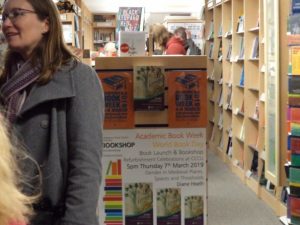
Louise Wilkinson chatting to others at the book launch
At the conclusion, I think in many ways two lines of thought had emerged, which can be summarised as a) the pilot project to take place between now and the summer, involving ‘Faversham Museums Together’ and Geography at CCCU, that will deploy about 15 maps, including the underlying geological survey, various OS maps, Jacob’s mid-18th-century map, and some modern maps such as Google to produce a much fuller version of what John had shown us. This to be in place in some form in the front exhibition space of 12 Market Place in August 2019 as a way of delivering the ‘wow’ factor and showcasing what can be done with such a system to residents and visitors, to the young and the not so young. Then having demonstrated the potential, stage b) to explore with interested groups how ‘their’ specific theme might be so mapped, as well as introducing extra technology such as hyperlinks, 3-D mapping and the use of mobile phone apps to bring in virtual reality, perhaps, all of which is likely to involve looking for sizeable outside funding. Those present agreed to take the pilot project forward, and the next step will be a meeting between Alex and Howard to establish an agreement, and thereafter at least a draft timetable. So ended an exceedingly interesting meeting and another very busy week.
 Centre for Kent History and Heritage
Centre for Kent History and Heritage Sheila Sweetinburgh
Sheila Sweetinburgh 1582
1582